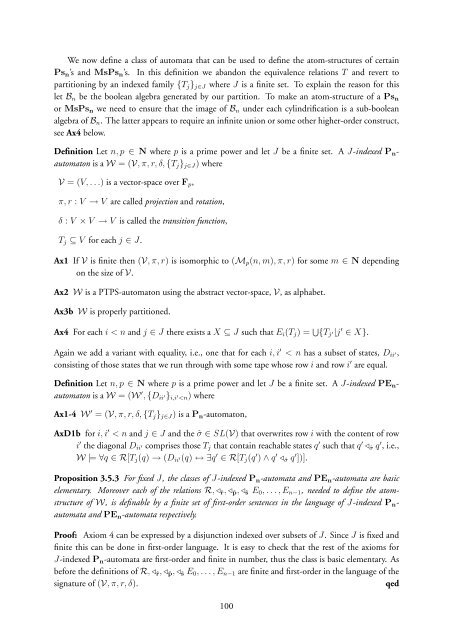On the methods of mechanical non-theorems (latest version)
On the methods of mechanical non-theorems (latest version)
On the methods of mechanical non-theorems (latest version)
Create successful ePaper yourself
Turn your PDF publications into a flip-book with our unique Google optimized e-Paper software.
We now define a class <strong>of</strong> automata that can be used to define <strong>the</strong> atom-structures <strong>of</strong> certain<br />
Ps n ’s and MsPs n ’s. In this definition we abandon <strong>the</strong> equivalence relations T and revert to<br />
partitioning by an indexed family {T j } j∈J where J is a finite set. To explain <strong>the</strong> reason for this<br />
let B n be <strong>the</strong> boolean algebra generated by our partition. To make an atom-structure <strong>of</strong> a Ps n<br />
or MsPs n we need to ensure that <strong>the</strong> image <strong>of</strong> B n under each cylindrification is a sub-boolean<br />
algebra <strong>of</strong> B n . The latter appears to require an infinite union or some o<strong>the</strong>r higher-order construct,<br />
see Ax4 below.<br />
Definition Let n, p ∈ N where p is a prime power and let J be a finite set. A J-indexed P n -<br />
automaton is a W = (V, π, r, δ, {T j } j∈J ) where<br />
V = (V, . . .) is a vector-space over F p ,<br />
π, r : V → V are called projection and rotation,<br />
δ : V × V → V is called <strong>the</strong> transition function,<br />
T j ⊆ V for each j ∈ J.<br />
Ax1 If V is finite <strong>the</strong>n (V, π, r) is isomorphic to (M p (n, m), π, r) for some m ∈ N depending<br />
on <strong>the</strong> size <strong>of</strong> V.<br />
Ax2 W is a PTPS-automaton using <strong>the</strong> abstract vector-space, V, as alphabet.<br />
Ax3b W is properly partitioned.<br />
Ax4 For each i < n and j ∈ J <strong>the</strong>re exists a X ⊆ J such that E i (T j ) = ⋃ {T j ′|j ′ ∈ X}.<br />
Again we add a variant with equality, i.e., one that for each i, i ′ < n has a subset <strong>of</strong> states, D ii ′,<br />
consisting <strong>of</strong> those states that we run through with some tape whose row i and row i ′ are equal.<br />
Definition Let n, p ∈ N where p is a prime power and let J be a finite set. A J-indexed PE n -<br />
automaton is a W = (W ′ , {D ii ′} i,i ′
















